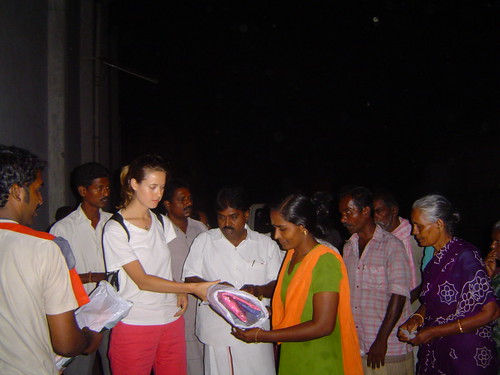
Last night, in the cool darkness that settled on Kasimedu just after
sunset, I distributed saris and lungis to 100 of the neediest families
in northern Chennai. This was my second visit to Kasimedu, a rundown
kuppam (neighborhood or area) in between the ocean and the one room
houses that wend their way through narrow lanes to the main road.
These people have lost everything. The tsunami struck down their
makeshift huts, shoddy to begin with, and then, after receiving aid
from the government, a fire swept through the encampment charring
everything, leaving nothing but dried out boat carcasses and piles of
ash and bits of cloth.
The stories the women and children told me on my last visit brought me
to tears--not an easy feat. I had been to four or five fishing
villages already, places that had lost hundreds of people to the wall
of water that descended upon them. These other places had sustained
quantifiably more damage, but they seemed to be coping. They were
rebuilding houses, had clean water from Unicef, and food from private
aid organizations. The children laughed and played in the street.
The women presided over their cooking fires, happy to have something
to do. However, the desperation of the women in Kasimedu was palpable.
They clustered around me, each talking over the other in an effort
to have her situation understood. This was a place where no one asked
me for money, they only motioned, bringing hand to mouth, that they
were hungry.
The smell of Kasimedu stayed with me after my first visit. Walking
through the black, ashy encampment, leveled by water, then dried by
flames, a deep, earthy acrid smell filled the air. When the village
women and children surrounded me, I was tempted to cover my mouth and
nose to shield the inner membranes of my orifices from the
stench—sweat mixed with dirt, dead fish, burned plastic, human
waste—all of it muddled together to create a foul odor that had seeped
into their hair and soiled their saris. How do they live here? The
wafting smoke from a Gold Flake cigarette was welcome. I inhaled the
second hand fumes heartily, just to have something to mask the smell
around me.
Two days before I was to leave Chennai, Narayan asked me what I wanted
to do about the villagers in Kasimedu. Did I want to go see them
again? Did I want to give them anything? I did, but I wanted to give
them things they could use. We needed to ask them what they wanted
first. Narayan went to work, and found out, through his fisher-friend
Patrick, that that day two foreigners had visited the kuppam and
handed out rice and kerosene. The people were so desperate for
supplies that they mobbed the donors, creating mass confusion. The
need for food overwhelmed the villagers and they grabbed and
quarreled, knocking things out of the donors' hands, some people not
receiving anything at all in the melee.
I wanted to avoid this situation. Having been in the middle of groups
of villagers tugging on my shirt, touching my hair, asking for money,
I knew that this could be a recipe for disaster. So, on my last day
in Chennai, Patrick devised an entire system to ensure that everything
would run smoothly. He found out through the head of the fisherfolk
that they needed clothing. Most women only had one sari, and some men
did not even have one lungi. We would have local men hand out tokens
to the neediest families, and later that night, they would bring a
token to a meeting point, and would be given a bag with one sari and
one lungi.
To me, a sari has always seemed like ceremonial garb. If I were to
buy one, I would only wear it to a wedding or a formal celebration.
But, here a sari is everyday attire. A poor woman will wear hers
during the day, and use it as a sheet at night. The same goes for a
lungi (very similar to a sarong, but worn exclusively by men). Men
wear lungis day and night, wrapping one around their waist to make a
long skirt, and looping it up, when mobility is needed, into what I
would call a mini-skirt.
Late in the afternoon, Narayan, Patrick, and I went to a wholesale
textile shop to buy the material. Fortunately, the shop owner gave us
a great deal because he knew that the material was intended for
tsunami victims. He sold the saris for Rs.60 and the lungis for Rs.
45. That's $1 for the men's piece, and $1.50 for the sari. My budget
only allowed me to buy 100 of each, but Patrick said anything would
help.
So, we loaded the material into a rickshaw and hustled back to the
meeting spot, an empty parking lot behind a rice mill. Patrick picked
this out of the way location so that we wouldn't get mobbed by the
general population. Overall, the system worked. It wasn't a great
time to hand out the goods, because it happened to be the time when
women are supposed to be tending their cooking fires. But, about 75
women and men showed up to accept the outfits. The rest will be given
out this morning.
Originally, when saris were suggested, I didn't like the idea. It
seemed like we'd be giving something superflous. But, Narayan
reminded me, "Food, clothing, shelter." They received food. There
was no time to build shelter. Clothing would have to do. I hope it
helps.
No comments:
Post a Comment
It is always great to hear from site visitors, whether your comments are positive or negative. Thanks for sharing your perspective.